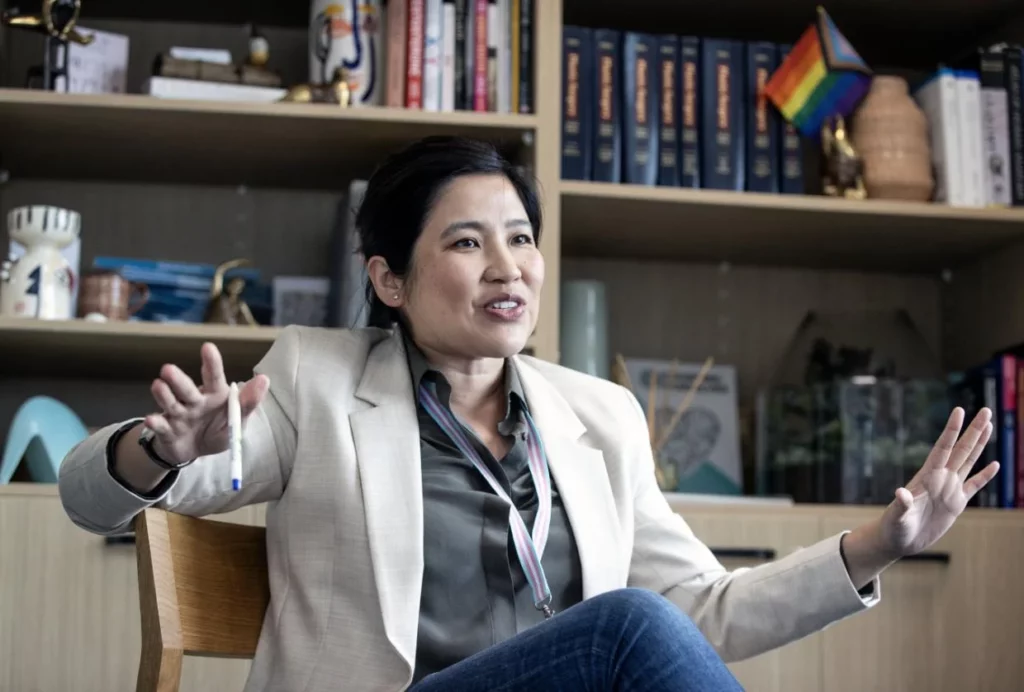Rita Yang had just handed in her resignation letter at Middlemore Hospital in Auckland when Whakaari/White Island erupted on December 9, 2019.
She had been hired for her expertise in gender affirming surgery and breast reconstruction. But working in an extremely stretched public healthcare system saw her stuck in elective surgery and she had done no genital reconstruction surgeries almost two years later.
The plastic and reconstructive surgeon, now working at Wakefield Hospital in Wellington, was at a crossroads.
She had returned from a three-year unpaid fellowship overseas to learn about gender affirming surgery but with no system or structure to support the sub-speciality work, she considered focusing on breast reconstruction where there was more security.
“It was a challenging time,” she says. “I [was] happy, but not happy.”
She had just decided to back herself and go private with gender affirming surgery when the eruption happened.
Yang stayed to be an extra pair of hands.
Visibly emotional, she recounted how all her colleagues worked around the clock to treat burn patients.
“You see what happens when you have an under-resourced system that preliminarily runs on the goodwill of humans,” she says.
“We can’t even withstand one crisis like that.”
The disaster was followed by Covid-19, and the period made her realise it was not enough to simply be trained in the techniques of surgery and patients she served.
Advocacy and collaboration with decision makers was equally important, and it gave her a new motive to continue on her path.
Yang is not the only surgeon undertaking gender-affirming work in Aotearoa and dislikes being labelled that. But she is the only surgeon trained in all forms of such surgery — and the only one to be able to perform genital reconstruction surgery in the country.
“You can say I’m the only trained gender surgeon in the country but actually, I can’t do anything on my own, I need a team.”
Yang was born in Taiwan as the eldest of three siblings. The family became a “long distance family” when the three moved to Aotearoa with their mum in 1995.
Her dad, a psychiatrist, stayed because his qualifications would not be recognised here, a common scenario amongst immigrant families back then, Yang says.
The move was initiated by her mum, largely to escape societal expectations and norms of a doctor’s family in Taiwan in the 1990s.
“She just wasn’t into it at all, she just wanted to travel. She wanted us to experience the world.”
Her mum, who was a pharmacist, did a diploma in art history and would sit alongside Yang at the table after dinner as both did their homework.
Yang’s dad would visit once a year. As the week came to an end, the teenagers would fall into “deep talks” with their dad on the last night while Georgie Pies cooled on the cooling rack.
“It was part of a ritual,” Yang says. Her mum would have bought 20 pies to cool so they could be frozen and packed into her dad’s suitcase to take back to Taiwan.
“It was just one of those times which were difficult but you find good bits out of it.”
Yang was accepted into Auckland University’s medical school and began studying in 1997 but took a pause when her mum was diagnosed with cancer. She chose to return to Taiwan for treatment and as a junior doctor, Yang spent 18 months nursing and caring for her.
Yang went to medical school with the intention to be a psychiatrist like her dad, having grown up spending time at the rehabilitation centre he set up.
But being on the other side of her mum’s hospital bed as the carer in palliative care, and not the doctor, gave her perspective – both in her career and realising Aotearoa was home.
When she returned, she began to carve a presence in a surgical career.
It wasn’t an easy path but the few female surgeons in plastic and reconstructive surgery became her role models and mentors.
She realised it was possible to be a woman – and a plastic surgeon.
Yang likes that it is broader than other surgical disciplines. It could be applied to any part of a person’s body to treat anything from cancer, trauma and reconstruction work like a cleft lip or burns.
People are surviving major traumas or being resuscitated more, and the discipline focuses on quality of life.
To Yang, “suffering is universal”. It doesn’t matter who walks through her door, it is her job to understand their needs, make a plan and give them the best care possible – not only to survive, but to live well.
“We should all be able to live without pain and deformity because the skill is there”, she says.
“It’s about a human problem, and there is time for us to plan because we’re dealing with that line beyond survival.”
There are currently 80 plastic surgeons in the country and the majority of them work in reconstructive surgeries, not cosmetic.
“There’s a lot of unseen need and therefore a lot of unmet need in what we do.”
In 2014, Yang qualified as a specialist plastic surgeon. She was one of two who qualified – on average three plastic surgeons are trained a year in Aotearoa.
It wasn’t long before she was approached by her mentor and the New Zealand Association of Plastic Surgery about gender affirming surgery.
The transgender community had been largely under-represented but increasingly began to have a presence in the public consciousness.
Yang had been firm about her interest in women’s health and women’s cancer reconstruction, but the transgender community was “a group of patients we didn’t know existed”, she says.
People were being sent overseas for surgery with the notion this would “fix them”, and there were no options for follow-up care when they returned. They had nowhere to turn.
It led her to undertaking a three-year fellowship, starting in Bangkok, Thailand, and going across Europe, absorbing as much knowledge as she could. She attended conferences, shadowed surgeons and learnt about how different systems – whether it be a medical tourism model like in Thailand, or publicly or privately funded – affected patients.
Receiving no financial support, despite applying, was stressful. But “it was fun”, she repeats, reflecting on the experience with fondness. It was a new field which meant there was endless opportunity to learn. That was exciting, and she was determined to serve a group of patients whose needs were being chronically unmet.
Yang was scrubbed up at a hospital in Amsterdam about to assist a surgery when a resident showed her that the Labour Government under Jacinda Ardern had been elected in 2017.
“I thought yup, it’s time to go home to New Zealand now.”
The following year, she was hired at Middlemore Hospital for her expertise in gender affirming surgery and breast reconstruction work.
But looking back and seeing how there was no system to support such surgery, no funding provision, sustainability or teamwork, it did not surprise her she wasn’t able to do any gender affirming surgery.
Not long after, the 2019 Budget saw $2.99 million go to funding up to 14 gender affirming genital surgeries a year for transgender people. In her eyes, it was the start of a fundamental shift in their care.
Previously, surgeries were financed through the high cost treatment model, a competitive pool of money for procedures not otherwise publicly funded.
She began knocking on doors, and when she was told people didn’t know anything about gender affirming surgery, she sat them down and told them all about the unmet need.
Someone once commented to her that all her patients were so intelligent and sophisticated as many had professors down as their title. But it was because there were no other gender neutral titles at the time.
“We’ve done a truckload in four years,” she says.
At Wakefield Hospital, there is now a dedicated team of nurses and a ward that looks after tailored gender care. They have a urologist and a gynaecologist on the gender team.
Training to make sure the system is equally set up for gender non-conforming people is given to all, including the receptionists.
It took time to build awareness, work efficiency, comfort and familiarity because no one had had any training before. But they have come a long way.
The funding helped them set up the only national multidisciplinary meetings involving referrers, surgeons, psychologists, peer navigators and funder-planners. The only surgical peer navigator was recruited; a national wraparound support network was set up, and it simplified and lowered the administrative threshold of applying for the waitlist.
“All the things we do [now], it’s probably because we had all the right people in the room.”
Although the waitlist for a first specialist assessment for surgery is still long, in four years they had seen and assessed five times more patients than in the previous 13 years in the high cost treatment pool model, and had already done twice as many surgeries.
“If this trend is to follow, it means that we’re not just delivering surgery for the sake of getting rid of the numbers on the waitlist, we’re actually delivering good quality surgical care, longitudinal while the patient enters the programme.”
The surgeries were major reconstructive surgeries and therefore it was a long process for patients, including two years of preparation work. But while the rate of needing to redo surgery under the previous funding model was 50%, under the current structure, the rate is 17%.
Yang put it down to the more intentional collaboration and activism in the area. People were being united by a purpose, and funding allowed for a mindset change and understanding of care.
It took away the concept of surgery as a commodity. Not every patient wants or needs the same surgery and after-care can look completely different for every person.
“Yes, the problem of our understaffed and under-resourced trauma, cancer care in the country and elective surgery care is still there – but this silo funding allows at least for what I want to advocate for, [it] allows us to progress that so much more.”
A lot of the focus now was less on patients proving their gender identity than on how to plan the process in the best and safest way possible, Yang says. “I’m really happy I get to be a part of this.”
But she has seen a lot of disruptions in the surgery process with a rise in transphobia in the last few years. The perception of antagonism created a lot more distress, she says.
The most under-served area of transgender healthcare is mental health support, Yang says.
She is deliberately trying to carve out time to focus on training and collaboration. One of her ambitions is to visit all regions in Aotearoa and build a funding network to focus on all forms of gender affirming surgery.
The Royal Australasian College of Surgeons is looking to have gender affirming surgeries incorporated into the formal plastic surgery training curriculum starting from 2025, with Yang taking on students as part of their training.
She is encouraged by what has developed and hopes the dialogue will continue.
“Of course long term I hope it’s more than $2.99 million but at least it allows a start and I would also say, this start also drives a lot of my national medical communities’ understanding and perception about this.”
Ultimately, it is about having a system which allows understanding and responding to a patient’s needs, listening, putting their plan together and walking through the life-long journey with them.
“It’s a privilege … whoever gets to be in that cave with their patient, they must be f…ing special, it’s a privilege for them to be there,” Yang says.
“I like to think when I’m advocating for a transgender person or breast cancer patient, I’m advocating for all – I like to think that.”
This article was, Published on The Post 04 May 2024.

